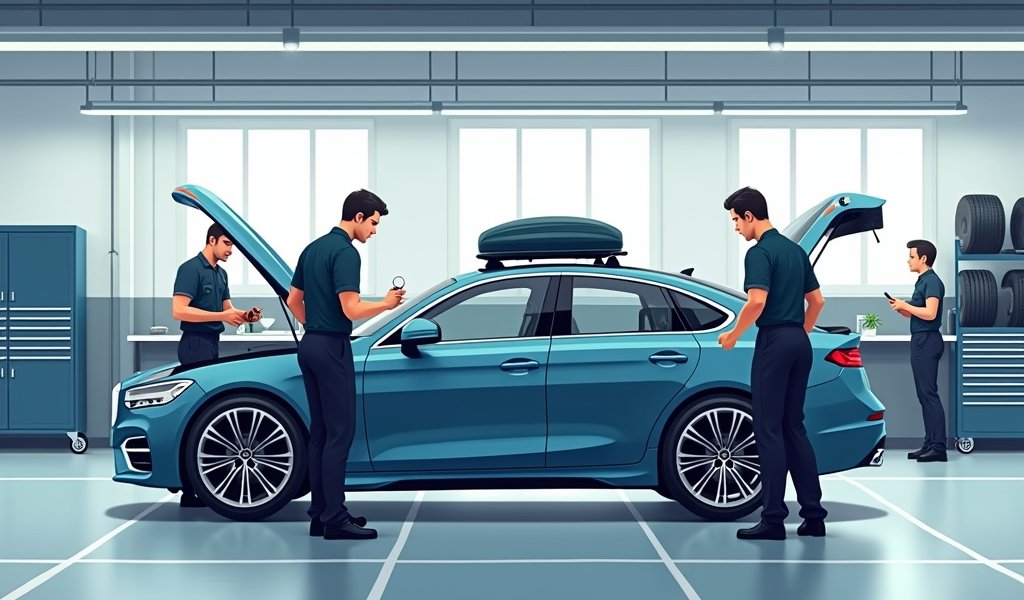Overview
This article provides essential guidance for preparing vehicles for road trips, covering critical checks for fluids, tires, brakes, battery systems, air conditioning, and emergency preparations. The guide emphasizes that thorough pre-trip vehicle preparation not only prevents breakdowns but also provides peace of mind, allowing travelers to focus on making memories rather than dealing with mechanical problems.
Table of Contents
- Road Trip Essentials: Why Preparation Matters
- Fluid Check: The Lifeblood of Your Vehicle
- Tire Inspection: Where the Rubber Meets the Road
- Brake System: Stopping Power When You Need It
- Battery and Electrical Systems: Powering Your Journey
- Air Conditioning and Comfort: Staying Cool on Hot Highways
- Emergency Kit: Be Prepared, Not Scared
- Final Pre-Trip Inspection: The Day-Before Checklist
- Conclusion: Hit the Road with Confidence
- Frequently Asked Questions
Road Trip Essentials: Why Preparation Matters
Planning how to prepare your car for a road trip isn’t just about preventing breakdowns—it’s about peace of mind. As a master mechanic with 20 years under my belt, I’ve seen countless vacation dreams deflate faster than a punctured tire because someone skipped the basics. Your vehicle is about to become your home on wheels, carrying precious cargo (you and your loved ones) across miles of unknown terrain.
Think of car prep like packing your suitcase—you wouldn’t leave for the beach without swimwear, so why hit the highway without checking your coolant? Road trips put unusual strain on vehicles: long hours of continuous operation, varying temperatures, and terrain challenges that your daily commute simply doesn’t present.
The open road beckons with promise, but that promise quickly sours when you’re stranded on a scorching shoulder waiting for roadside assistance. A thorough inspection before departure can save you not just money but the precious commodity of vacation time. Let’s walk through a comprehensive approach to preparing your vehicle for extended travel, ensuring your focus stays on making memories, not making repair appointments.
Fluid Check: The Lifeblood of Your Vehicle
Your car’s fluids are its lifeblood—each one serving a critical function in the complex dance of mechanical components. Let’s start with the most vital: oil. Fresh engine oil reduces friction and heat, two enemies that multiply during long drives.
Check your dipstick first—is the oil at the proper level? More importantly, when was your last oil change? If you’re approaching or past the recommended interval, schedule a change before departure. Dark, gritty oil indicates it’s time for fresh fluid, regardless of mileage.
Next, inspect these essential fluids:
- Coolant/antifreeze: Should be between “min” and “max” marks on the reservoir, with a sweet smell and bright color (usually green, orange, or pink)
- Brake fluid: Check the reservoir level and note any darkening (should be clear to light amber)
- Power steering fluid: Often overlooked but critical for control
- Transmission fluid: If equipped with a dipstick, should be red and sweet-smelling, not brown and burnt
- Windshield washer fluid: Fill to capacity—you’ll use more than you think!
Remember that fluids don’t just need to be present—they need to be clean and properly formulated. Your cooling system, for instance, might need different protection in Death Valley than in Denver. When in doubt, consider a professional fluid check at a certified service center where technicians can spot issues that might escape untrained eyes.

Tire Inspection: Where the Rubber Meets the Road
Your tires form the only contact between your two-ton vehicle and the asphalt below—four patches of rubber each about the size of your hand. Pretty sobering when you think about it! Before embarking on your journey, give these critical components the attention they deserve.
Start with a thorough tire inspection before your trip. Examine the tread depth using the penny test—insert a penny with Lincoln’s head upside down into the tread groove. If you can see all of Lincoln’s head, your tires need replacement. Ideally, you shouldn’t embark on a long trip with less than 4/32″ of tread remaining.
Look for these warning signs of tire trouble:
- Uneven wear patterns (indicating alignment issues)
- Bulges or blisters on sidewalls (potential blowout hazards)
- Cracks in the rubber (age deterioration)
- Foreign objects embedded in tread (slow leaks waiting to happen)
Proper inflation stands as perhaps the most overlooked aspect of tire maintenance. Check pressure when tires are cold, using the manufacturer’s recommended PSI (found on the driver’s doorjamb sticker—not the sidewall maximum). Underinflated tires flex more, creating heat and increasing blowout risk while reducing fuel economy. Overinflated tires provide a harsh ride and wear prematurely in the center.
Don’t forget your spare! That donut or full-size backup is useless if flat or deteriorated. Verify its condition and pressure, and ensure your jack and lug wrench are present and functional. Highway shoulders are no place to discover missing equipment.
Brake System: Stopping Power When You Need It
The ability to stop confidently might save your life and those of others—making brake inspection non-negotiable before any extended journey. Like silent sentinels, your brakes stand ready for emergency duty, but they can only perform when properly maintained.
Listen for warning sounds during normal driving: squealing, grinding, or pulsations through the pedal all indicate potential issues. If your pedal feels spongy or requires excessive pressure, air might be trapped in the lines—a condition requiring professional attention.
Visual inspection can reveal a lot about brake health. Look for these signs through your wheel spokes:
- Thin brake pads (less than ¼ inch of friction material)
- Scored or grooved rotors (uneven shiny patches)
- Leaks around wheel cylinders or calipers
- Rust buildup on components (especially after winter)
Testing brake responsiveness requires an empty parking lot or quiet road. From about 30 mph, apply moderate pressure—your car should stop in a straight line without pulling to either side. Next, try a few gentle stops from lower speeds to feel for pulsations indicating warped rotors.
Remember that mountain driving demands more from your braking system than flat highways. If your route includes significant elevation changes, consider a brake fluid flush if it’s been more than two years since the last one. Fresh fluid has a higher boiling point, crucial for preventing brake fade during prolonged downhill sections.
Battery and Electrical Systems: Powering Your Journey
Modern vehicles are rolling computers, dependent on reliable electrical systems for everything from engine management to navigation. At the heart of this system sits your battery—silent until it fails, then suddenly the loudest problem you’ve got!
Most batteries last 3-5 years, but extreme temperatures accelerate aging. Check your battery’s date code (typically a letter representing the month and a number for the year) to determine its age. Batteries rarely give warning before failure, but signs of impending doom include:
- Slow engine cranking, especially on cool mornings
- Dimming headlights at idle
- Electronic systems resetting while driving
- Swollen battery case or corrosion on terminals
A visual inspection should include checking for clean, tight connections. White or greenish powder around terminals indicates corrosion that restricts current flow. Clean this using a mixture of baking soda and water, then rinse and dry thoroughly.
Beyond the battery, verify all lighting systems function properly—headlights, turn signals, brake lights, and hazards. A blown bulb might seem minor, but it can lead to a traffic citation or, worse, contribute to an accident when another driver misinterprets your intentions.
If your vehicle has key fob entry, bring a spare battery for the remote. Nothing dampens vacation spirit faster than being locked out of your car at a remote scenic overlook! Also check that your vehicle safety systems warning lights aren’t illuminated, as these could indicate compromised protection.

Air Conditioning and Comfort: Staying Cool on Hot Highways
Comfort might seem like a luxury until you’re trapped in a metal box under the summer sun with cranky passengers. Your climate control system deserves attention before departure, particularly for summer travel when heat stress can affect driver alertness and passenger harmony.
Start by running your air conditioning at maximum for several minutes. The air should feel significantly colder than ambient temperature within 60-90 seconds. If cooling seems weak or produces unpleasant odors, your system may need attention.
Common A/C issues before road trips include:
- Refrigerant leaks (indicated by intermittent cooling)
- Clogged cabin air filters (restricting airflow)
- Mold growth in evaporators (causing musty smells)
- Belt wear (creating squealing noises under load)
The cabin air filter deserves special attention—typically replaced every 15,000-30,000 miles, this component traps dust, pollen, and debris before they enter your breathing space. A clogged filter restricts airflow while a clean one improves system efficiency and air quality. Most filters hide behind the glove compartment and can be replaced with basic tools in under 20 minutes.
Don’t forget to test your defrosters as well. Even summer travelers might encounter morning fog or sudden rain showers. Verify both front and rear defrosters operate correctly—functioning defrosters are not just about comfort but safety through proper visibility.
Emergency Kit: Be Prepared, Not Scared
Even perfectly maintained vehicles can encounter unexpected situations. Smart travelers prepare for contingencies with a well-stocked emergency kit. Think of it as insurance you hope never to use—but you’ll be grateful to have when needed.
Your road trip emergency kit should include:
- Flashlight with extra batteries
- Basic first aid supplies (bandages, antiseptic, pain relievers)
- Reflective warning triangles or flares
- Jumper cables or portable jump starter
- Basic tools (screwdrivers, pliers, adjustable wrench)
- Tire pressure gauge and portable inflator
- Duct tape and zip ties (temporary fixes for numerous issues)
- Water bottles and non-perishable snacks
- Weather-appropriate items (blanket, rain poncho)
- Phone charger or power bank
For trips to remote areas, consider adding a paper map as backup to GPS systems and extra fluids specific to your vehicle. A quart of oil, gallon of coolant premixed to manufacturer specifications, and brake fluid matching your system’s requirements can be lifesavers when far from service stations.
Don’t overlook the importance of having your insurance information and roadside assistance details readily accessible. Store your insurance card, vehicle registration, and emergency contact numbers in a waterproof container or take photos of these documents on your phone. Many insurance providers offer mobile apps with digital ID cards and direct connection to emergency services.
A complete road trip maintenance checklist should include your emergency preparedness items alongside mechanical inspections. The peace of mind from knowing you’re ready for unexpected situations allows you to fully enjoy the journey.
Final Pre-Trip Inspection: The Day-Before Checklist
The day before departure represents your last opportunity for a thorough inspection. With bags packed and routes mapped, take 30 minutes for this critical final check. Like a pilot’s pre-flight routine, this methodical approach can catch issues that might otherwise surface miles from home.
Begin with a walk-around inspection in good lighting. Look for:
- Fluid leaks under the vehicle (fresh spots on clean pavement)
- Tire condition and pressure (including spare)
- Secure gas cap and body panels
- Clean windows and functional wipers
- Working lights (have a helper verify brake and turn signals)
Next, open the hood for a final fluid check and visual inspection of hoses and belts. Squeeze coolant hoses near clamps—they should feel firm but not rock-hard. Look at drive belts for cracks or fraying on edges. Verify that all caps are tight and dipsticks fully seated.
Inside the vehicle, test all comfort and convenience features you’ll rely on during your journey. This includes seating adjustments, climate controls, audio systems, charging ports, and navigation tools. Clear any dash warning lights before departure—even seemingly minor warnings can indicate developing problems.
If you’re traveling with roof-mounted cargo or a trailer, double-check all mounting hardware and safety chains. Test trailer lights if applicable, and verify that your vehicle’s tire pressure accounts for the additional load (consult your owner’s manual for heavy-load pressure recommendations).
Finally, pack a small bag with essential documents, including:
- Vehicle owner’s manual
- Warranty information
- Insurance details
- Roadside assistance contacts
- Service history
This methodical approach might seem excessive, but experienced road-trippers know that an ounce of prevention truly equals a pound of cure when you’re far from familiar territory.
Conclusion: Hit the Road with Confidence
Preparing your car for a road trip isn’t just mechanical maintenance—it’s investing in the success of your adventure. When your vehicle runs smoothly, you can focus on making memories instead of making emergency repair calls. The peace of mind that comes from knowing you’ve covered all bases allows for genuine relaxation on the open road.
Remember that different seasons and destinations may require specific preparation beyond these fundamentals. Winter travelers face unique challenges with cold-weather starting and traction, while summer desert crossings test cooling systems to their limits. Tailor your preparations to your specific journey while maintaining these core principles.
Throughout this guide, we’ve explored how to prepare your car for a road trip from fluids to tires, brakes to batteries, and comfort to emergency readiness. Each system plays a vital role in the symphony of components that carry you safely to your destination. By giving attention to these details before departure, you dramatically improve your odds of a trouble-free journey.
The open road awaits with endless possibilities. With your vehicle properly prepared, you can embrace those possibilities with confidence, knowing you’ve done your part to ensure mechanical concerns won’t derail your plans. Safe travels!
Frequently Asked Questions
How long before a road trip should I have my car checked?
Ideally, have your car inspected 1-2 weeks before departure. This provides enough time to address any issues discovered without rushing repairs or delaying your trip.
Do I need to change my oil before a long road trip?
If you’re within 1,500 miles of your next scheduled oil change, it’s wise to change it before departing. Fresh oil provides maximum protection during the continuous operation of long-distance driving.
What’s the most common breakdown issue on road trips?
Tire problems (including blowouts and punctures) remain the most common road trip breakdown issue. Thorough tire inspection and proper inflation are your best preventive measures.
Should I use premium fuel for my road trip if I normally use regular?
Unless your vehicle manufacturer specifically recommends premium fuel, upgrading for a road trip provides no benefit. Stick with the octane rating specified in your owner’s manual.
How much emergency cash should I bring on a road trip?
Keep $100-200 in small bills for emergencies where card payments aren’t accepted. Remote service stations, small-town repair shops, and toll roads sometimes require cash payment.

